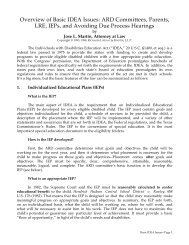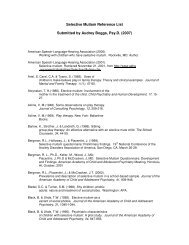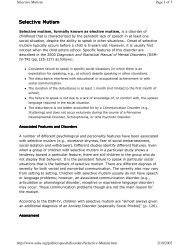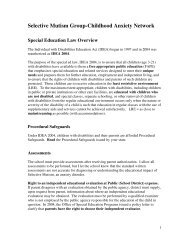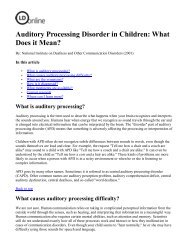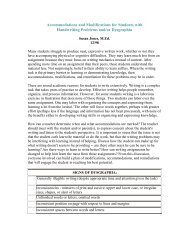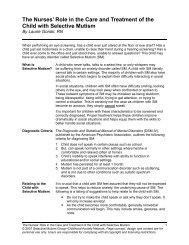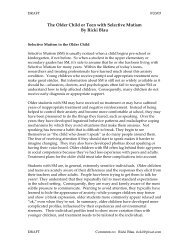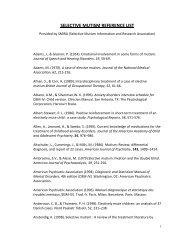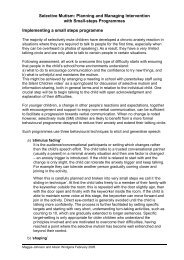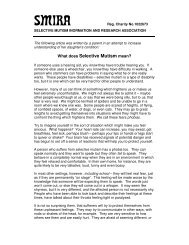No Child Left Behind
No Child Left Behind: Understanding Assessment Options for ... - ERIC
No Child Left Behind: Understanding Assessment Options for ... - ERIC
Create successful ePaper yourself
Turn your PDF publications into a flip-book with our unique Google optimized e-Paper software.
®A Parent Advocacy Brief fromNational Center Learning DisabilitiesforThe power to hope, to learn, and to succeed.<strong>No</strong> <strong>Child</strong> <strong>Left</strong> <strong>Behind</strong>:Understanding Assessment Optionsfor IDEA-eligible StudentsThe Elementary and Secondary Education Act (ESEA) is the nation’smajor federal law related to education in grades pre-kindergartenthrough high school. In its most recent Congressional reauthorization,ESEA became known as the <strong>No</strong> <strong>Child</strong> <strong>Left</strong> <strong>Behind</strong> Act (NCLB) of 2001.Under NCLB public school students throughout the country mustparticipate in annual testing in specific academic areas and gradesoutlined in the law. This requirement includes students who requirespecial education services under the Individuals with DisabilitiesEducation Act (IDEA).These assessment requirements were put into place as a way todetermine if the school is adequately educating every student incritical core academic areas. The results of these assessments, alongwith other indicators, are used to determine if schools are providingsubstantial and continuous improvement in the academic achievementof all students and to determine if schools are achieving “adequateyearly progress” (AYP) based on the state’s target for studentproficiency.IDEA-eligible students arestudents who have been foundeligible to receive specialeducation and related servicesunder the Individuals withDisabilities Education Act(IDEA). In order to receive suchservices, students must havean Individualized EducationProgram (IEP) in effect.Parents of IDEA-eligible students need to understand the assessmentrequirements of NCLB and the important decisions they will needto make as part of their child’s educational program. The selection ofthe most appropriate assessment option is the focus of this parentadvocacy brief.NCLB: Understanding Assessment Options for IDEA-eligible Students 1
State Requirements and NCLBEven before the enactment of NCLB, many states had startedtesting students at many grades and in many academic areas aspart of their statewide education reform activities. Consequently,students may also be expected to participate in assessmentsin other subject areas, such as history, geography, and writingskills, if and when the state requires it. However, NCLB requiresassessments only in the areas of reading/language arts, math, andscience at certain grades (see sidebar).Additionally, some states have chosen to add “stakes” forstudents to their standards and assessment systems. In somestates, students are required to pass one or more high schoolassessments as a condition of receiving a diploma. Some statesrequire students to achieve at certain levels on tests to bepromoted to subsequent grades. However, student “stakes” arenot a requirement of NCLB.In order to make informed decisions about a child’s participation instatewide testing, parents should familiarize themselves with theirstate’s assessment policies and understand which assessmentrequirements are associated with NCLB.Information about each state’s NCLB accountability plan* isavailable on the state’s department of education Web site.To locate state information, visit http://wdcrobcolp01.ed.gov/Programs/EROD/org_list.cfm?category_ID=SEA and clickon the state. The same Web site includes information aboutaccommodations available to IDEA-eligible students whentaking state mandated tests. Be sure to obtain a copy of allaccommodation information and policies for the state.*<strong>No</strong>te: States can and do request changes to their NCLB accountability plans,so be sure to obtain information on the latest plan, which may not be availableon the Web site, but can be obtained via a request to the state department ofeducation.<strong>No</strong> <strong>Child</strong> <strong>Left</strong> <strong>Behind</strong>Annual AssessmentRequirementsBy the 2005-2006 school year:Subject area:Reading/Language Arts & MathGrades tested:Each year, grades 3 through 8Once during grades 10-12By the 2007-2008 school year:Subject area:Science*Grades tested:Once during grades 3-5Once during grades 6-9Once during grades 10-12*While all schools are required toadminister Science assessments,schools are not held accountablefor student performance on theseassessments.NCLB: Understanding Assessment Options for IDEA-eligible Students 2
Understanding Assessment OptionsThe annual assessments, or tests, required by NCLB are based oneach state’s academic content standards and academic achievementstandards in reading/language arts, mathematics and science.NCLB requires that each state have “challenging” academic contentstandards and the same expectations for all children. States’ academicachievement standards must be aligned with the content standards andhave at least three achievement levels, two levels of high proficiency(proficient and advanced) and a third level of achievement (basic) todescribe progress of lower-achieving children. Academic content andachievement standards can and do vary from state to state.Students who receive services under the Individuals with DisabilitiesEducation Act (IDEA), generally referred to as “special education”services, can be assessed via one of five possible options. All optionsmay not exist in every state.Who Decides: Determining how an IDEA-eligible student willparticipate in the statewide assessment system is the responsibilityof the Individualized Education Program (IEP) Team, which includesthe student’s parent. The IEP team may not exempt a student fromparticipating in the assessments required by NCLB. In fact, schoolsmust ensure that all students enrolled in the school are participating inthe assessments required by NCLB.The options for the participation of IDEA-eligible students in statewidetesting required by NCLB can include:OPTION 1: Regular assessment based on the state’s academiccontent standards scored against the state’s grade-level academicachievement standards: This is the same assessment taken bystudents without disabilities. Many IDEA-eligible students will be able toparticipate in statewide testing in this manner.OPTION 2: Regular assessment based on the state’s academiccontent standards, with appropriate accommodations as definedby the state, scored against the state’s grade-level academicachievement standards: This is the same assessment taken bystudents without disabilities. IDEA-eligible students must be providedwith the appropriate accommodations necessary to measure theiracademic achievement. The majority of IDEA-eligible students will beable to participate in statewide testing in this manner.IMPORTANT TERMS TO KNOWAcademic Content Standards specifywhat children are expected to knowand be able to do, contain coherentand rigorous content and encouragethe teaching of advanced skills. Eachstate determines its academic contentstandards. All students should haveaccess to and be assessed on theirenrolled-grade-level content.Academic Achievement Standards arealigned with the academic contentstandards; describe at least 3 levels ofachievement (advanced, proficient andbasic) that determine how well childrenare mastering the material in theacademic content standards. Each statedetermines its academic achievementstandards. Alternate academicachievement standards typically reflectreduced depth, breadth or complexityof learning or expectation whilemaintaining alignment to the gradelevel academic content standards.Accommodations are changes intesting materials or proceduresthat ensure that a test measuresthe student’s knowledge and skillsrather than the student’s disabilities.Accommodations are generallygrouped into the following categories:• presentation (e.g., repeatdirections, read aloud, use oflarger bubbles);• response (e.g., mark answers inbook, use reference aids, point,computer);• setting (e.g., study carrel, speciallighting, separate room) and• timing/scheduling (e.g., extendedtime, frequent breaks).Adequate Yearly Progress (AYP) is agoal for annual improvement thatstates, school districts, and schoolsmust make each year in order to reachNCLB’s requirement to have everystudent proficient in reading and mathby the year 2014.NCLB: Understanding Assessment Options for IDEA-eligible Students 3
OPTION 3: Alternate assessment based on grade-levelacademic content standards scored against the state’s gradelevelacademic achievement standards (with or withoutappropriate accommodations as defined by the state):This assessment measures the same academic content andachievement expectation as Option 1 using a different approachother than the traditional pencil and paper test. Examples ofalternate assessments include teacher observations; samplesof student work that demonstrate mastery of the contentstandards tested by the statewide assessment, and standardizedperformance tasks. <strong>No</strong>t all states offer this option. If it’s available,many IDEA-eligible students will be able to participate instatewide assessments in this manner, which is more favorablethan Option 4 or 5.OPTION 4: Alternate assessment based on grade-levelacademic content standards scored against modifiedacademic achievement standards (with or withoutappropriate accommodations as defined by the state): Thisassessment measures achievement on grade-level academiccontent using a different or modified expectation of performance.NCLB sets limitations on the number of assessment scores forIDEA-eligible students that can be used to determine a school’sand district’s status regarding the attainment of adequate yearlyprogress (see chart on pages 6 and 7).<strong>No</strong>te: This assessment option is not the same as “out-of-level” or “instructionallevel” assessments. Such assessments are not based on the student’s assignedgrade-level academic content standards (see endnote on page 8).OPTION 5: Alternate assessment aligned with gradelevelacademic content standards scored against alternateacademic achievement standards: This assessment measuresachievement on grade-level academic content standards at areduced depth, breadth and complexity and uses an achievementstandard that differs in complexity from a grade-level achievementstandard. This assessment option is intended for students whosecognitive impairments may prevent them from attaining gradelevelachievement standards, even with the very best instruction.“Out-of-level” or “instructional level” assessments are includedin this option; however, any such assessments must be alignedwith the grade-level academic content standards of the state.Although there is no limit on how many IDEA-eligible studentscan participate in alternate assessments, NCLB sets a limit onthe number of proficient assessment scores for IDEA-eligiblestudents that can be used to determine school and district statusregarding the attainment of adequate yearly progress (see charton pages 6 and 7).NCLB: Understanding Assessment Options for IDEA-eligible Students 4
How To Make an Informed Decision for Your <strong>Child</strong>These options should be viewed on a continuum. Option 1 is themost desirable way for an IDEA-eligible student to participatein statewide assessments. Most IDEA-eligible students shouldbe expected to participate in statewide testing via Option 1 or 2(including most students with learning disabilities). In making theassessment participation decision, the IEP Team should movealong the list of options, making sure to base its decision on theindividual student and the highest expectations for that student.Decisions regarding the assessment option should be tailoredto each individual student and should not be made based on thedisability category of the student, i.e., all students with the samedisability should not participate in the same testing option.Additionally, the IEP Team should make assessment participationdecisions each year and for each assessment. For example, astudent may need one of the alternate assessment options inReading/Language Arts in Grade 4, but be able to participateusing the regular grade-level assessment with appropriateaccommodations in Math in Grade 4. The same student may beable to participate in the regular grade-level assessments in bothReading/Language Arts and Math in Grade 5.**<strong>No</strong>te: Ideally, all of these options should be available to the student; however,not all states currently permit decisions to be made separately for each contentarea assessment.Every IDEA-eligible student’s IEP must contain a statement ofany individual appropriate accommodations that are necessary tomeasure the academic achievement and functional performanceof the student on state- and district-wide tests, includingassessments required by NCLB, and whether the student willparticipate in the regular assessment or an alternate assessment.Parents need to fully understand the implications of participationin the various testing options and should be informed of thepotential consequences, if any, for their child. For example, aparent should be advised if a state will not allow a student tograduate with a regular diploma if he or she takes an alternateassessment based on modified or alternate standards (Options 4and 5), including “out-of-level” assessments.NCLB: Understanding Assessment Options for IDEA-eligible Students 5
Making Assessment Decisions for IDEA Eligible StudentsWHAT WHO HOWOPTION 1Regular assessment based onthe state’s academic contentstandards scored against thestate’s grade-level academicachievement standards.OPTION 2Regular assessment basedon the state’s academiccontent standards, withappropriate accommodationsas defined by the state, scoredagainst the state’s gradelevelacademic achievementstandards.(All states are required to offerappropriate accommodationsand develop accommodationguidelines)OPTION 3Alternate assessment basedon grade-level academiccontent standards scoredagainst the state’s gradelevelacademic achievementstandards (with or withoutappropriate accommodationsas defined by the state).(States have the option of offeringthis assessment)4 All students, including IDEA-eligiblestudents.4 Any IDEA-eligible student (or studenton a Section 504 Plan).4 Any IDEA eligible student (served byany of the disability categories of IDEA).4 There is no limitation on the numberof IDEA eligible students who can beassessed using this option.4 IEP Team decision.4 IEP Team decision.4 IEP Team determines the appropriateaccommodations needed by the studentbased on guidance from the state.Assessment accommodations may differfrom instructional accommodations.4 Accommodations must conform to stateguidelines for appropriate accommodationsthat do not invalidate test scores.4 IEP Team decision.4 IEP Team determines the appropriateaccommodations; assessmentaccommodations may differ frominstructional accommodations.4 Accommodations must conform to stateguidelines for appropriate accommodationsthat do not invalidate test scores.4 Student’s scores are treated the sameas those of regular assessments for school/district AYP determinations.NCLB: Understanding Assessment Options for IDEA-eligible Students 6
Making Assessment Decisions for IDEA Eligible StudentsWHAT WHO HOWOPTION 4Alternate assessment basedon grade-level academiccontent standards scoredagainst modified academicachievement standards(with or without appropriateaccommodations as definedby the state).(States have the option of offeringthis assessment and must providecertain assurances to the U.S.Department of Education in orderto do so)OPTION 5Alternate assessment alignedwith grade-level academiccontent standards scoredagainst alternate academicachievement standards.(States must make an alternateassessment available)4 Any IDEA eligible student (served byany of the disability categories of IDEA).4 There is no limit the number ofstudents with disabilities who can takethis type of assessment, however,States may include proficient scoresfrom this assessment in making AYPdeterminations only up to 2 percentof the total tested population (roughly18 percent of IDEA-eligible studentsnationally). This limitation applies at theschool district (LEA) and State level—notat the school level. Scores of studentsthat exceed the limit must be countedas non-proficient.4 Any IDEA eligible student (served byany of the disability categories of IDEA).4 Reserved for students with the mostsignificant cognitive disabilities.4 There is no limitation on the numberof IDEA eligible students who can beassessed using this option, however,States may include proficient scoresfrom this assessment in making AYPdeterminations only up to 1 percentof the total tested population (roughly9 percent of IDEA-eligible studentsnationally). This limitation applies at theschool district and State level—not atthe school level. Scores of students thatexceed the limitation must be countedas non-proficient.4 IEP Team decision.4 Parents must be informed thatachievement is based on modifiedachievement standards.4 Modified achievement standards mustbe aligned with the state academic gradelevelcontent standards.4 IEP Team determines the appropriateaccommodations; assessmentaccommodations may differ frominstructional accommodations.4 IEP Team decision.4 Parents must be informed thatachievement is based on alternateacademic achievement standards.4 Alternate academic achievementstandards must be aligned with the stateacademic grade-level content standards.4 IEP Team determines the appropriateaccommodations; assessmentaccommodations may differ frominstructional accommodations. (Sincethese alternate assessments have beenspecifically developed for students withthe most significant cognitive disabilities,accommodations are not usually a concern.)4 Must not result in placements orassignments to a curriculum that does notinclude academic content.NCLB: Understanding Assessment Options for IDEA-eligible Students 7
Questions Parents Should Ask About Assessment Participation Options1. Is this assessment one of those required by the <strong>No</strong> <strong>Child</strong> <strong>Left</strong> <strong>Behind</strong> Act (NCLB)?Many states administer far more statewide assessments than those required by NCLB, so it is importantto understand which tests are state mandated and which are required by NCLB. In some cases, states areusing the state mandated tests to also satisfy NCLB requirements.2. What topics does the test cover?NCLB requires schools to measure students’ progress in reading/language arts, math and science. In orderfor test results to be meaningful, the student must have the opportunity to learn the material on which thetest is based. This does not mean, however, that schools must abandon the focus on providing for otherindividual needs, such as behavioral and functional needs, as stated in the student’s IEP.3. Can I preview the assessment?<strong>No</strong>t all states will allow parents to examine the actual assessment, but samples should be available forparents to view. Previewing the test allows parents to examine the content, which should ideally align withwhat the teacher is presenting in the classroom.4. What accommodations are available?NCLB requires all states to make available the appropriate accommodations needed by students withdisabilities. States should have guidelines on the accommodations available on statewide assessmentswhich do not invalidate the test score. School districts are responsible for providing training to IEP Teammembers, including parents, on how to make sound decisions regarding accommodations.5. What is the effect of my student doing well or poorly on the test?NCLB requires that school districts receiving Title I funds (about 90 percent of school districts) use astudent’s testing results to identify learning problems and improve instruction. If your child does poorly, askwhat support and remediation will be provided as a result. Ask how your child’s classroom instruction canbe adjusted as a result of the testing performance.Some states have policies that attach high stakes, such as grade retention or awarding of high schooldiplomas, to test performance. Such “stakes” are not a requirement of NCLB. Be sure to ask for andunderstand the implications of statewide assessment performance as well as the implications forparticipation in the assessment options offered by your state.6. Who has access to my child’s test scores?The 1974 Family Education Rights and Privacy Act (FERPA) gives parentsthe right to inspect and review their child’s educational records andmandates that access to their child’s records be limited to certain schoolofficials. While NCLB requires schools, school districts and states topublicly report assessment scores, such information is reported bystudent groups and subgroups and must protect individual studentconfidentiality.Endnote: Information is based on the best available information as of July 2005.Final regulations regarding Alternate Assessments scored against modifiedacademic achievement standards were not available at the time of writing.NCLB: Understanding Assessment Options for IDEA-eligible Students 8
®National CenterforThe power to hope, to learn, and to succeed.Learning DisabilitiesThe National Center for Learning Disabilities, Inc., is a nonprofitorganization dedicated to ensuring that the nation’s 15 million childrenand adults with learning disabilities have every opportunity to succeed inschool, work, and life. NCLD provides essential information to parents,professionals, and individuals with learning disabilities, promotesresearch and programs to foster effective learning, and advocates forpolicies to protect and strengthen educational rights and opportunities.For more information, please visit us on the Web at www.LD.org, andwww.getreadytoread.org.Schwab Learning is a nonprofit program of the Charles and HelenSchwab Foundation dedicated to helping kids with learning and attentionproblems be successful in school and life. Schwab Learning developsand delivers resources that provide parents of kids with learningdifficulties, and kids themselves, with practical information, empathicsupport, and trustworthy guidance. Schwab Learning services aredelivered through two websites, one designed specifically for parents atSchwabLearning.org and another created expressly for kids ages 8-12 atSparkTop.org, as well as through outreach and community services.Visit www.LD.org/NCLB forthese companion publications:• Making the ‘<strong>No</strong> <strong>Child</strong> <strong>Left</strong><strong>Behind</strong> Act’ Work for <strong>Child</strong>renWho Struggle to Learn: AParent’s Guide• Making the Most of Options forIDEA-eligible Students• Determining AppropriateAssessment Accommodationsfor Students with DisabilitiesAbout the AuthorCandace Cortiella is Director of The Advocacy Institute (www.AdvocacyInstitute.org), a nonprofit focused on improving the livesof people with learning disabilities through public policy and otherinitiatives. She also serves on the Professional Advisory Boards of theNational Center for Learning Disabilities and Smart Kids with LearningDisabilities. The mother of a young adult with learning disabilities, shelives in the Washington, D.C. area.© 2005 National Center for Learning Disabilities, Inc. All rights reserved. This publicationis provided free of charge by the National Center for Learning Disabilities. Widedissemination is encouraged! Copies may be made and distributed in keeping with thefollowing guidelines: The publication must be reproduced in its entirety, including pagescontaining information about the author, the National Center for Learning Disabilities,and Schwab Learning. Copies of the publication may not be sold.This publication was made possible withfunding from the Charles and Helen Schwab Foundation.NCLB: Understanding Assessment Options for IDEA-eligible Students 9



